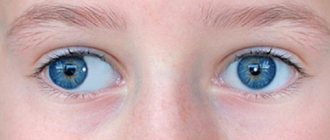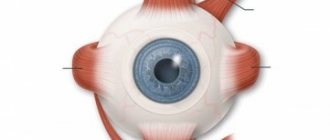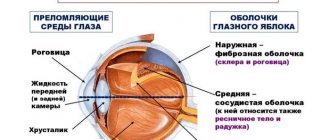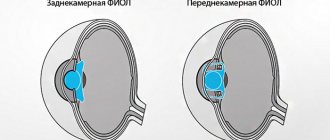Sometimes, when stroking babies up to 3-4 months old, it may seem as if their eyes are squinting. In fact, in most such cases, as a rule, there is no medical problem: the bevel occurs due to the structural features of the facial skull (due to a skin fold at the corner of the eye or the wide bridge of the nose). Several months will pass, and there will be no trace left of the former slight “squint.”
Meanwhile, to calm the parent’s soul, it is useful to conduct a series of special tests (the so-called differentiated diagnosis between false and true strabismus), which will certainly convince the baby’s parents that there is no problem. We can talk about true strabismus only when the ophthalmologist has identified certain oculomotor disorders in the child.
Even if visually, when looking at a baby, one gets the impression of slight strabismus, but there are clearly no oculomotor disorders, then this condition is not a pathology - it is called false strabismus, and does not require any therapeutic measures.
And since strabismus in children can be not only congenital, but also acquired (its symptoms usually appear in children under 3 years of age), examinations by an ophthalmologist must be periodic.
Show your child to a pediatric ophthalmologist regularly: preventive examinations should be carried out at 2, 6 and 12 months, once a year until the age of 6-7 years. If an eye pathology is detected, the pediatric ophthalmologist will prescribe an individual schedule of visits.
Causes of true strabismus in children
The reason for the development of strabismus is the inconsistency in the work of the two eyes, the impossibility of their working together.
Strabismus can be congenital or early acquired, and can appear between the ages of 1.5 and 3-4 years. The fact is that at this age the formation of finer structures of the visual system continues, and the final phase of the formation of binocular (that is, volumetric, stereoscopic) vision occurs.
The child grows up, begins to look at pictures, collect pyramids and construction sets, play educational games - his visual work begins and gradually increases. Therefore, it is during this period that there is a risk of strabismus, which increases significantly if the child has congenital farsightedness or anisometropia (in other words, a difference in refraction between the right and left eyes), neurological pathology (for example: cerebral palsy, Down syndrome).
On the other hand, any stress on the body can be a provoking factor for the appearance of strabismus in children: vaccination, viral disease, fear or shock, high temperature.
If parents do not begin treatment for the child in a timely manner, strabismus develops into a serious functional pathology. For example:
- a child with strabismus cannot merge images from both eyes into a single image - the brain turns off the squinting eye from the act of vision;
- a child with strabismus cannot perceive spatial volume, i.e. 3D format - he sees the world as flat.
In total, about 25 types of childhood strabismus are known in ophthalmology today, each of which requires a special, individual approach to treatment.
The task of a pediatric ophthalmologist is to determine the type of strabismus, the cause of its occurrence in the child and prescribe the child the treatment that he needs at that particular moment.
Is strabismus always noticeable with the naked eye?
Strabismus can be vertical, divergent and convergent, most often with one or both eyes clearly squinting. However, there is also a hidden form of childhood strabismus, which is not outwardly noticeable. It occurs due to muscle imbalance and is dangerous because it causes rapid eye fatigue.
This, in turn, leads to myopia. The disorder develops in the first months of life, and can manifest itself more clearly in the third year of life, when the child is interested in activities that require visual strain - modeling, drawing.
Sometimes strabismus is observed in newborns. This is due to weakness of the eye muscles and is normal. The reason for contacting an ophthalmologist is the presence of obvious strabismus in a child older than six months.
When is it necessary to treat strabismus?
If you are told that strabismus will go away on its own, or that treatment needs to be carried out when the child grows up, look for another ophthalmologist. This is the wrong approach. You will waste valuable time!
Treatment of strabismus in children should begin immediately from the moment of diagnosis and, best of all, in a specialized children's eye clinic. The first therapeutic measures are possible from the age of 5-6 months. At this age, the child can get his first glasses (if there are refractive errors). Modern frames are made of safe and durable materials and are absolutely safe for the baby!
Causes of the development of the disease in newborns, infants and older children
It is possible to determine the cause of strabismus in a child after a special ophthalmological examination.
The cause of a congenital disease can be:
- difficult childbirth;
- illnesses suffered during pregnancy;
- use of certain medications and drugs by the expectant mother;
- genetic abnormalities (Down syndrome);
- heredity;
- prematurity;
- congenital eye abnormalities;
- cerebral palsy;
- hydrocephalus.
Acquired strabismus develops acutely or gradually. The following factors contribute to this:
- farsightedness, myopia. In order to see objects that are far or close, the child has to strain his eyes, as a result of which strabismus occurs over time;
- past infectious diseases (measles, scarlet fever, influenza);
- injuries;
- stress, severe psychological shock;
- high eye strain;
- diseases of the nervous system that lead to disruption of communication between the brain and eyes.
How to treat strabismus
In order to completely rehabilitate a child and achieve results, it is necessary to carry out the correct comprehensive treatment, developed individually for the child. As a rule, the course of treatment includes the following activities:
- individual occlusion mode (special occlusions for the better seeing eye);
- correctly selected spectacle correction;
- a set of therapeutic techniques to improve visual acuity and develop binocular functions;
- if necessary, surgical intervention (in order to make the gaze symmetrical and even).
Diagnostic methods: how to determine congenital and acquired strabismus
The method for determining strabismus at home is based on the ability of the pupils of the eye to reflect bright light. Therefore, self-diagnosis of a baby can be carried out in the following ways:
- Shine a not very bright flashlight in the direction of the child’s face (distance cm): if the light is reflected synchronously in the pupils, then everything is in order with the eye muscles. But if the reflection of light is not the same in the two pupils, you need to go with the child to an ophthalmologist.
- Take a photo of the baby with a flash while he looks into the lens. The problem can be recognized in the same way as in the first method.
Treatment
The sooner treatment for true strabismus is started, the less likely the child is to lose visual acuity and remain cross-eyed for life. Therefore, ophthalmologists usually prescribe complex therapy immediately after identifying the problem, and at the age of 2 years, children are already successfully operated on. Treatment of strabismus includes the following techniques:
- orthopedic therapy helps to correct the brain in maintaining the functioning of the eye muscles. Classes can be conducted either at a computer using special programs or on orthopedic simulators. The only disadvantage of this treatment is that only older children can master it - after 4 years;
- Reflexology is a technique of acupressure, with which a specialist acts on the nerve centers. They, in turn, regulate the coordination of the muscles of the eyeball. In complex therapy, it allows not only not to lose vision, but in some cases to improve it and keep the eye muscles in good shape;
- the operation is performed after the age of two, truncating the long muscle of the eye, as a result of which the pupils stop scattering due to the previously relaxed state;
- for children of kindergarten age, it is recommended to visit adapted child development centers, where there are special rooms with orthopedic simulators, ophthalmologists who regularly examine children and conduct corrective classes with them;
- sometimes children are prescribed electrophoresis to relax muscles and improve nerve conduction;
- Occlusion of a healthy eye helps to activate the work of pathologically developed tissues of the second eye. For this, both ordinary bandages and special children's eye patches are used;
- may prescribe osteopathic therapy, which is more related to alternative medicine, but gives amazing results. This treatment involves influencing the structures and fluids of the human body using the hands of an osteopath. As a result, the tissues relax, the passage of nerve impulses improves, and the muscles become toned, which is extremely important for strabismus in infants.
If strabismus is not treated, then the children's brain responds to pathological processes in the eye muscles with compensatory mechanisms in the brain, which over time leads to serious problems with vision, up to its severe decrease. Therefore, even if you suspect functional strabismus, it is better to visit a specialist for preventive purposes, so as not to aggravate the child’s problem in the future.
Strabismus in children: to operate or not?
The decision to perform an operation should be made only by a pediatric eye doctor who is treating the child based on the state of his visual functions.
In approximately 85% of cases of strabismus in children, regardless of its type and the cause of its occurrence, surgical intervention is justified and necessary.
The pediatric eye surgeon chooses the method of performing the surgical stage based on the type of strabismus and the specific case of imbalance between the extraocular muscles. Today, one of the most effective surgical techniques for correcting strabismus in children is considered to be the method of mathematical modeling of a future operation and the use of radio wave technologies.
Causes of strabismus
The causes of strabismus are very diverse. They can be either congenital or acquired:
- the presence of ametropia (farsightedness, myopia, astigmatism) of medium and high degrees;
- injuries;
- paralysis and paresis;
- abnormalities in the development and attachment of the extraocular muscles;
- diseases of the central nervous system;
- stress;
- infectious diseases (measles, scarlet fever, diphtheria, influenza, etc.);
- somatic diseases;
- mental trauma (fear);
- a sharp decrease in visual acuity in one eye.
Is the operation dangerous?
Modern surgery has become precise and less traumatic. Including through the use of mathematical modeling of future operations and radio wave technologies.
The use of radio wave technologies ensures the most minimally traumatic operation and a reduction in rehabilitation time - after all, the operation is performed without incisions! After surgery to correct strabismus, the child is discharged from the hospital the very next day.
If a pediatric eye surgeon uses mathematical modeling of an operation, its accuracy is practically guaranteed, and he can show the planned result of the operation to the child’s parents even before the date of the operation is determined.
Description of the disease
Strabismus (strabismus) is the inability to focus on an object of interest with both eyes at the same time. Normally, the eye muscles should move together, which allows you to focus your gaze in one place. With strabismus, muscle function is impaired, one or both eyes deviate from the central axis, that is, they look in different directions, and the brain fails to combine two visible images into one.
With strabismus, the work of the eye muscles is impaired, one or both eyes deviate from the central axis
Minor deviations are observed in almost all infants. Newborns and infants up to 2–3 months cannot yet fix their gaze due to weakness of the eye muscles and insufficient control over them, so a slight squint at this age is a variant of the norm. By 3–6 months, the baby begins to coordinate eye movements.
If a six-month-old child’s eyes continue to “float” and look in different directions, you need to show the baby to a specialist.
At the age of two or three years, when the formation of friendly eye functioning occurs, there is a danger of developing true strabismus. The first signs of the disease that parents should pay attention to are a wandering gaze, an unnatural tilt of the baby’s head. Sometimes you can notice an anomaly in photographs of a child taken with a flash.
In older age, the occurrence of pathology can be triggered by previous injuries, infectious diseases, and inflammatory eye diseases. Sometimes strabismus develops again. After surgery to correct the defect in childhood, the muscles that were involved in the pathological process weaken again and the disease returns.
Strabismus negatively affects the psyche and character of the child. In the absence of binocular vision (perception of the surrounding world with two eyes), the baby cannot determine the location of surrounding objects, and this often provokes a delay in physical and mental development.
Children's strabismus - video
Prevention
To avoid childhood strabismus, it is not enough to follow the rules of visual hygiene. It is also important to develop the extraocular muscles no less than others. The baby pulls himself up to build strength in his arms, runs to add endurance to his legs, so why don’t we train our eyesight?
Starting from birth and focusing on preschool years, do eye gymnastics with your child every day. Soon it will become a habit and will take just a couple of minutes. For a baby in a stroller, exercises with pictures are suitable - first in black and white, later in color. Children of kindergarten age can use puzzles to benefit their eyes, and schoolchildren can do gymnastics with you before they sit down to do their homework.
Monitor how your child watches TV - do not allow too close a distance. The same applies to all kinds of gadgets. Watching cartoons while lying down with a tablet, as well as playing games on the small screen of a mobile phone, are especially dangerous.
Types of disease
The international classifier defines several types of disease that can develop in childhood. If parents want to know how to determine strabismus in a child, then they need to first establish its types. The pathological condition can manifest itself as:
- Isotropy, this type of disease is classified as the most common. In this case, there is a bevel inward toward the nose area of 1 or 2 eyes. In most episodes, this form of the disease is observed in children under one year of age. With this strabismus in children, the causes of which are congenital, farsightedness may be observed.
- Exotropia, this form of the disease is most often diagnosed between the ages of 1 and 6 years. Often, with this pathological condition, myopia is observed.
- Hypotropia, hypertropia. In these forms of the disease, the eye deviates vertically up or down. This form of the disease is quite rare. It is often diagnosed after 11 years of age due to diseases of the eye muscles or innervation.











